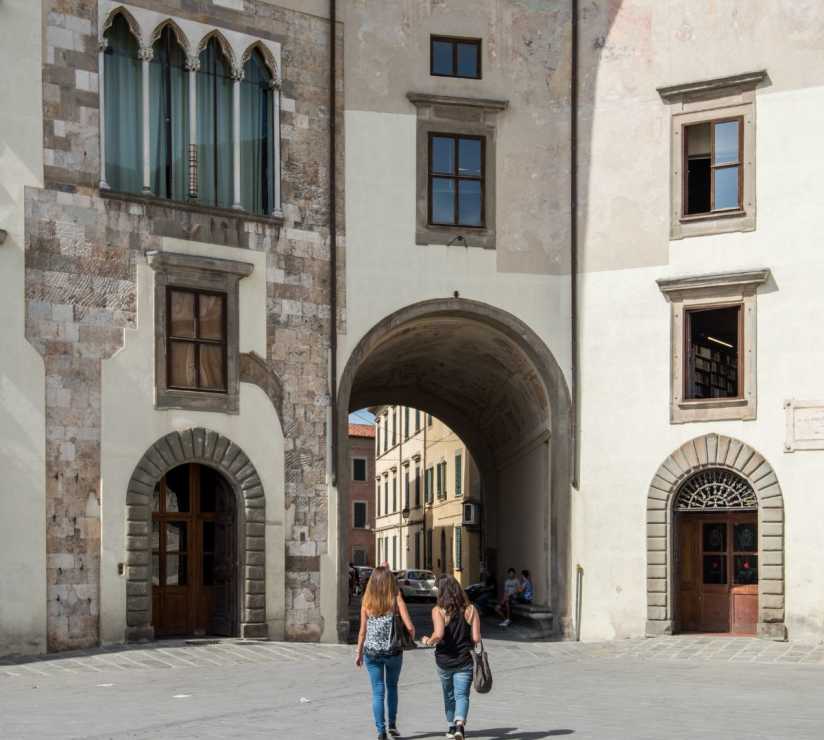Table Of Contents
- Planning Your Visit: Getting to This Italian City
- First Impressions: The Leaning Tower and UNESCO World Heritage Site
- The Cathedral: More Than Just a Backdrop
- Beyond the Main Sites: Exploring Pisa's Other Attractions
- Local Life: Markets and Neighborhoods
- The Arno River: Pisa's Natural Beauty
- Hidden Gems: Santa Maria della Spina
- University Quarter: Academic Energy
- Other Areas Worth Exploring
- Practical Considerations: Time and Logistics
- Evening Rhythms: Aperitivo and Local Life
- Day Trip Connections: Pisa as a Base
- Returning: Reflections on the Day
- Making the Most of Limited Time
- Why Pisa Works for Day Trips
Planning Your Visit: Getting to This Italian City
The train from Florence arrives at Pisa train station at 9:47 AM, three minutes behind schedule. I'm here to visit Pisa for one day, and honestly, I'm not sure what to expect beyond the obvious bell tower (campanile). When planning things to do in Pisa Italy in one day, the main train station feels surprisingly busy for a Tuesday morning, with day trippers, university students, and locals heading to work.
For those planning a Pisa visit, the logistics are straightforward. The Pisa train station connects easily to other cities in the Tuscany region, including Florence (one hour), La Spezia (45 minutes for Cinque Terre connections), and Rome (three hours). A rental car isn't necessary unless you're planning to explore beyond the city itself. All the things to do in Pisa in one day fit within a few hours of walking.
The walk from the main train station to Piazza del Duomo takes about twenty minutes on foot. There's also the Pisa Mover, an automated shuttle system, but walking reveals the real character of this small city. The route cuts through residential neighborhoods that feel refreshingly normal after other Italian cities' tourist-heavy centers.
First Impressions: The Leaning Tower and UNESCO World Heritage Site
Twenty-five minutes after leaving the Pisa train station, I round a corner and there it is. The campanile, leaning at its famous angle, looking exactly like every photograph I've ever seen, except somehow more improbable in person. The lean is dramatic enough that you genuinely wonder how it stays upright.
But here's what photos don't capture: Piazza del Duomo or Cathedral Square (also known as Piazza dei Miracoli) is a vast UNESCO World Heritage site. The tower doesn't dominate the space so much as anchor it alongside the cathedral, baptistery, and monumental cemetery. These famous landmarks create a composition that's been refined over centuries. Even at 10:30 AM, tourists are already positioning themselves for classic photos, but the square is large enough to find quieter corners.
The grass is genuinely green, kept perfect by an army of groundskeepers. I find a spot away from the main flows and sit for a few minutes, watching the choreography of organized groups and independent travelers. The tower tickets are sold out for the day, but the view from ground level tells the story clearly enough.
The Cathedral: More Than Just a Backdrop
The Pisa Cathedral sits next to the leaning tower, and most visitors barely give it a second glance. This turns out to be a mistake. The entrance is free, and stepping inside feels like discovering a parallel universe to the crowded piazza outside.
The pulpit by Giovanni Pisano is extraordinary, carved with scenes that seem to move in the filtered light. I spend nearly an hour here, partly because it's beautiful and partly because it's blissfully quiet. The cathedral's acoustics are remarkable; when a small tour group tests the echo, their voices seem to hang in the air before fading.
For those interested in deeper context, the Museo dell'Opera del Duomo houses additional treasures from the cathedral complex, though it requires an extra cost beyond the free cathedral entry. Combined with the Museo delle Sinopie, these two museums showcase centuries of religious art and offer insights into the construction of these monumental buildings.
Looking for a private city experience in Pisa?
Explore the city with a local who plans a private day just for you; no groups, no scripts.
Beyond the Main Sites: Exploring Pisa's Other Attractions
By noon, I'm ready to explore beyond the main sites. The monumental cemetery (Camposanto) closes off the fourth side of Piazza del Duomo, its Gothic arcades containing remarkable frescoes that survived World War II bombings. The Museo delle Sinopie, nearby, displays the preparatory drawings for frescoes damaged in the war, worth visiting for art history enthusiasts.
Walking toward the city center, the Piazza dei Cavalieri, designed by Vasari, showcases Renaissance architecture including the Palazzo della Carovana with its striking sgraffito facade. The clock tower here provides a quieter alternative to the crowded bell tower experience.
The beautiful city reveals itself in layers. Corso Italia, the main pedestrian street, connects the historic center to the train station area. Along the way, traditional shops sell everything from local specialties to university textbooks, reflecting Pisa's dual identity as tourist destination and academic center.
Local Life: Markets and Neighborhoods
Time for lunch away from the tourist zones. Piazza delle Vettovaglie hosts a small market where locals shop for daily necessities. The scene feels authentically Italian - vendors selling vegetables, cheese, and flowers to residents.
I buy a sandwich from a small shop on the square's edge, filled with local salami and sharp pecorino. The owner asks where I'm from and seems genuinely pleased when I mention Munich. The sandwich costs three euros (probably half what I would have paid near the tower).
This is where you discover traditional dishes beyond tourist menus. The market vendors offer ingredients for ribollita, pappa al pomodoro, and other Tuscan specialties. Even a few hours spent in local neighborhoods reveals the rhythm of daily life that exists parallel to the tourist experience.
The Arno River: Pisa's Natural Beauty
After lunch, I walk toward the River Arno, following narrow streets that feel medieval in scale. The river cuts through the city center, and the buildings along its banks show centuries of flood marks and renovation. The afternoon light hits the water perfectly, creating reflections that shift with every passing cloud.
The Palazzo Blu sits along the riverbank, currently hosting temporary exhibitions on Pisan maritime history. The entry fee is modest, and the museum is pleasantly uncrowded. I learn that this small city was once a major naval power, rivaling Venice and Genoa. History that makes the current quiet character feel almost fictional.
Walking along the Arno River, I pass couples on benches, university students reading, and elderly residents feeding pigeons. The river provides a natural break from the intensity of the main tourist circuit, offering space to think clearly about what you've seen.
What if your day in Pisa was planned by someone who knows it — and you?
City Unscripted matches you with a local host who creates a private experience based on your interests, not a set route.
Hidden Gems: Santa Maria della Spina
About fifteen minutes along the river, I discover Santa Maria della Spina, a small Gothic church that sits directly on the Arno's banks. It's so small it barely qualifies as a church, more like a reliquary made of marble and spires. This counts among Pisa's hidden gems, mentioned briefly in guidebooks but surprising in person.
The church was built to house a thorn from Christ's crown, brought back from the Holy Land, though the relic was later moved for safekeeping. What remains is pure architectural jewelry, every surface carved with saints, angels, and botanical motifs. The afternoon light makes the marble seem to glow from within.
I spend twenty minutes walking around the church, trying to understand how medieval craftsmen achieved such delicate stonework. Because of the damage caused by the frequent flooding of the Arno, in 1871 the church was dismantled and rebuilt one meter higher than its initial position. The church is currently the location of temporary art exhibitions.
University Quarter: Academic Energy
The University of Pisa, founded in 1343, gives the city energy that pure tourist destinations often lack. Walking through the university quarter in the late afternoon, I encounter students discussing everything from physics to philosophy. The campus buildings blend seamlessly with medieval architecture.
As one of the things to do in Pisa for a day, the Botanical Garden, maintained by the university, offers a peaceful alternative to the main tourist circuit. Founded in 1543 (initially located on the banks of the Arno river, it was moved to its current location in 1591), it's one of Europe's oldest academic botanical gardens. The entrance fee is minimal (full tickets priced at €4), and the gardens provide genuine escape from the day's walking.
I sit on a bench next to a pond where turtles sun themselves on logs. The contrast with the morning's crowds couldn't be more dramatic. Here, the pace feels academic, contemplative, removed from the urgency of day trip schedules.
Other Areas Worth Exploring
For those with extra time for things to do in Pisa, several other sites merit attention. The Osteria dei Cavalieri restaurant has amazing food, great service and fantastic wine.
San Francesco, a 13th-century church, contains important frescoes and offers a quieter spiritual experience. The city walls, partially intact, provide walking paths with elevated views over the Tuscany region landscape.
Piazza Garibaldi and Piazza Vittorio Emanuele II showcase different periods of urban development, from medieval to modern. Borgo Stretto, a narrow shopping street, maintains its medieval character while serving contemporary needs. Even Google Maps shows how these areas connect to form a walkable whole.
The church of Santa Maria Assunta, though less famous than the cathedral, contains beautiful artwork. For those interested in contemporary culture, check what temporary exhibitions are running at various galleries, Pisa's academic community supports an active cultural scene.
Tip
We match you with the right host, not just any guide.Want to experience the real Pisa with someone who lives there?
A fully private experience, planned and led by a local host who tailors the day to you
Practical Considerations: Time and Logistics
Planning one day in Pisa requires realistic expectations. The main sites can be covered in three hours, but a proper Pisa visit benefits from a more relaxed pace. High season (summer months) brings crowds that can make the experience feel rushed, while shoulder seasons offer better opportunities for contemplation.
A two hour tour covers the basics, but independent exploration reveals more character. Travel insurance is wise for any trip, and Google Maps helps navigate the compact city center. The Pisa Mover connects major sites efficiently, though walking remains the best way to discover unexpected corners.
For gelato enthusiasts, Gelateria de Coltelli, near the university, serves exceptional flavors using local ingredients. It's worth the detour from the main tourist areas and represents the kind of authentic experience that makes day trips memorable.
Evening Rhythms: Aperitivo and Local Life
By six o'clock, I'm ready for aperitivo, the Italian tradition that transforms early evening into social art. The streets around Piazza delle Vettovaglie come alive with locals meeting for drinks and small plates. I choose a wine bar clearly not targeting tourists, the menu isn't translated.
The Vermentino wine is local, crisp, and pairs perfectly with olive oil-soaked bread and aged cheese. Wine tasting in Pisa might not match the Chianti region's reputation, but local varieties offer pleasant surprises. The conversation around me is entirely in Italian, discussing everything from local politics to weekend plans.
The owner, a man in his forties with paint-stained fingers, explains that he's an artist during the day and runs the wine bar in the evenings. His paintings hang on the walls, local scenes rendered in bold colors that capture the light I've been noticing all day.
Day Trip Connections: Pisa as a Base
One advantage of visiting Pisa is its connections to other cities. La Spezia, gateway to Cinque Terre, is 45 minutes by train. Monterosso al Mare, the largest Cinque Terre village, makes a possible day trip extension, though that's a tall order combined with a full Pisa visit.
The Ligurian Sea is closer than you might expect, and the Roman aqueduct ruins near San Rossore offer historical context for the region. Parco Don Bosco provides green space if you need a break from urban sightseeing, though it's not essential for an Italy in one day visit.
For those questioning whether Pisa is worth the trip, the answer depends on expectations. If you're seeking another Florence or Rome, you'll be disappointed. If you want a beautiful city with manageable scale and genuine character, Pisa delivers.
Ready to plan your perfect day in Pisa?
Start your experienceReturning: Reflections on the Day
Walking back to Pisa Centrale station, I pass through the same neighborhoods I encountered this morning, but they feel different now. Families are having dinner, television light flickers behind curtains, and the day's heat is finally dissipating. This is the Pisa that exists when guidebooks are closed.
The train back to Florence is half-empty, filled mostly with commuters and a few other day trippers. I watch the Tuscan countryside pass in fading light, thinking about the difference between seeing a place and understanding it. A day trip provides glimpses, impressions, a sense of scale and character.
For those considering Pisa experiences, I'd recommend mixing obvious attractions with deliberate wandering. The leaning tower earns its fame, but the city's quieter moments provide equally valuable memories.
Making the Most of Limited Time
If you're planning one day in Pisa, start early and allow time for wandering. Morning light in Piazza del Duomo is extraordinary, and crowds build steadily throughout the day. The cathedral is free and remarkable, worth as much time as the tower itself.
Don't skip lunch away from the tourist zone. The neighborhoods around Piazza delle Vettovaglie offer authentic local food at reasonable prices. The university quarter adds intellectual energy to medieval architecture, and the Botanical Garden offers genuine tranquility.
For those interested in Pisa cultural tours, consider that the city's culture includes daily rhythms as much as historical monuments. The aperitivo hour, evening passeggiata, and market life all contribute to character.
Why Pisa Works for Day Trips
As the train pulls away from the main train station, I'm struck by how manageable this Italian city feels. Unlike Florence or Rome, where a day trip barely scratches the surface, Pisa can be experienced meaningfully in limited time. The scale is human, walking distances reasonable, and the mix of famous attractions and local life creates satisfying balance.
The bell tower provides the initial draw, but the city's appeal extends well beyond its most famous monument. Gothic architecture, river setting, university energy, and good food all contribute to a day that feels complete rather than rushed.
One day in Pisa taught me that not every destination needs to be overwhelming to be worthwhile. Sometimes a city's greatest gift is its ability to be understood quickly, appreciated deeply, and remembered fondly. In an age of overtourism, Pisa offers something increasingly rare: a famous destination that still feels accessible and human-scaled.
The key is approaching it with right expectations. Come for the tower, but stay for the river walk. Plan for the cathedral, but leave time for aperitivo. Pack lightly, walk slowly, and remember that the best travel stories often come from moments between main attractions.
What if your day in Pisa was planned by someone who knows it — and you?
City Unscripted matches you with a local host who creates a private experience based on your interests, not a set route.
Want to experience the real Pisa with someone who lives there?
A fully private experience, planned and led by a local host who tailors the day to you










